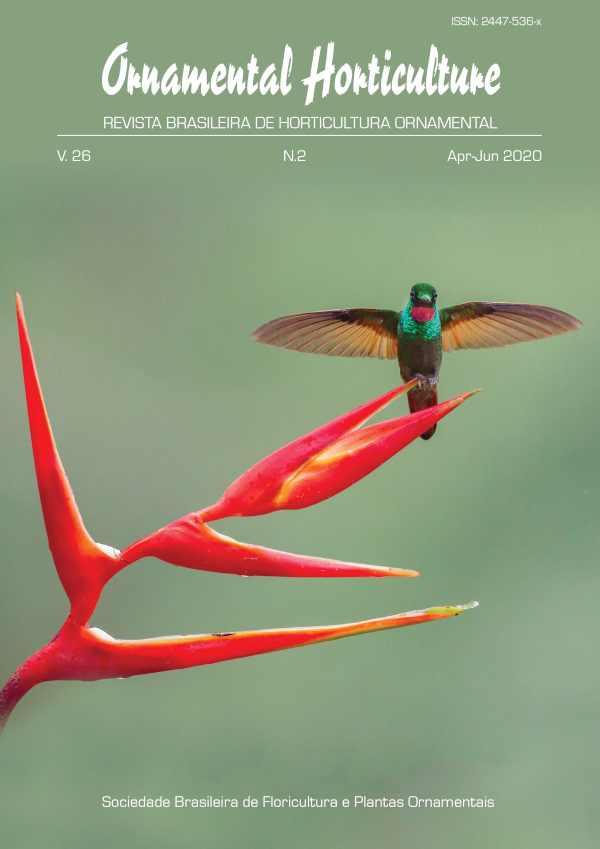Ver ítem
- xmlui.general.dspace_homeCentros Regionales y EEAsCentro Regional Mendoza - San JuanEEA La ConsultaArtículos científicosxmlui.ArtifactBrowser.ItemViewer.trail
- Inicio
- Centros Regionales y EEAs
- Centro Regional Mendoza - San Juan
- EEA La Consulta
- Artículos científicos
- Ver ítem
Differential growth response of green and variegated Ficus benjamina to exogenous cytokinin and shade
Resumen
Benjamin fig (Ficus benjamina) is an important foliage and landscape crop species comprising green and variegated genotypes. The latter develop leaves with yellow and white leaf areas which may impose lower photosynthetic activity, thus resulting in slower
growth than green genotypes. In many species, the exogenous supply of cytokinin to pot-grown plants promotes growth, mainly due to enhanced carbon fixation. In this work, we analyze the effect of
[ver mas...]
Benjamin fig (Ficus benjamina) is an important foliage and landscape crop species comprising green and variegated genotypes. The latter develop leaves with yellow and white leaf areas which may impose lower photosynthetic activity, thus resulting in slower
growth than green genotypes. In many species, the exogenous supply of cytokinin to pot-grown plants promotes growth, mainly due to enhanced carbon fixation. In this work, we analyze the effect of spraying the cytokinin 6-benzylaminopurine (BAP) on
growth and development of green and variegated Ficus benjamina genotypes. Two experiments were carried out in a greenhouse, in which either different number of BAP applications (Experiment 1) or different BAP concentrations (Experiment 2) were tested. In Experiment 2, plants were grown under three different light intensities. BAP sprays promoted rate of leaf appearance, leaf expansion and whole-plant growth, and the effect was stronger in variegated than in green plants. The relative growth rate promotion by BAP was associated with increased net assimilation rate rather than with variation in the leaf area ratio. On the other hand, shading had a more negative impact on growth and development of variegated plants than in green ones. Variegated plants, unlike green ones, developed leaves with high specific leaf area under the lowest light intensity. This led to high leaf area ratio values, which helped to maintain relative growth rates close to those of plants under moderate shading.
[Cerrar]
O Ficus (Ficus benjamina) é uma importante espécie de folhagem usada no paisagismo que compreende genótipos verdes e variegados. Estes últimos desenvolvem folhas com áreas foliares amarelas e brancas que podem impor menor atividade fotossintética, resultando em crescimento mais lento que os genótipos verdes. Em muitas espécies, o suprimento exógeno de citocinina em plantas cultivadas em vaso promove o crescimento, principalmente devido à maior fixação de
[ver mas...]
O Ficus (Ficus benjamina) é uma importante espécie de folhagem usada no paisagismo que compreende genótipos verdes e variegados. Estes últimos desenvolvem folhas com áreas foliares amarelas e brancas que podem impor menor atividade fotossintética, resultando em crescimento mais lento que os genótipos verdes. Em muitas espécies, o suprimento exógeno de citocinina em plantas cultivadas em vaso promove o crescimento, principalmente devido à maior fixação de carbono. Neste trabalho, analisamos o efeito da pulverização da citocinina 6-benzilaminopurina (BAP) no crescimento e desenvolvimento de genótipos verdes e variegados de Ficus benjamina. Foram realizadas dois experimentos em casa de vegetação, nos quais foram testados diferentes números de aplicações de BAP (Experimento 1) ou diferentes concentrações de BAP (Experimento 2). No experimento 2, as plantas foram cultivadas sob três intensidades de luz diferentes. A pulverização com BAP promoveram taxa de aparência foliar, expansão foliar e crescimento de plantas inteiras, e o efeito foi mais forte em variegadas do que em plantas verdes. A promoção da taxa de crescimento relativo pelo BAP foi associada ao aumento da taxa líquida de assimilação, e não à variação na proporção da área foliar. Por outro lado, o sombreamento teve impacto mais negativo no crescimento e desenvolvimento de plantas variegadas do que nas verdes. Plantas variegadas, diferentemente das verdes, desenvolveram folhas com alta área foliar específica sob a menor intensidade de luz. Isso levou a altos valores da razão de área foliar, o que ajudou a manter taxas de crescimento relativas próximas às das plantas sob sombreamento moderado.
[Cerrar]

Autor
Di Benedetto, Adalberto;
Galmarini, Claudio Romulo;
Tognetti, Jorge;
Fuente
Ornamental Horticulture 26 (2) : 259-276. (abril de 2020)
Fecha
2020-04
Editorial
Sociedade Brasileira de Floricultura e Plantas Ornamentais
ISSN
2447-536X
Formato
pdf
Tipo de documento
artículo
Palabras Claves
Derechos de acceso
Abierto
 Excepto donde se diga explicitamente, este item se publica bajo la siguiente descripción: Creative Commons Attribution-NonCommercial-ShareAlike 2.5 Unported (CC BY-NC-SA 2.5)
Excepto donde se diga explicitamente, este item se publica bajo la siguiente descripción: Creative Commons Attribution-NonCommercial-ShareAlike 2.5 Unported (CC BY-NC-SA 2.5)


